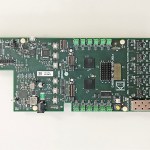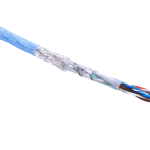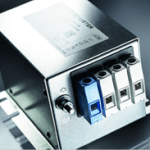This week’s roundup of new products includes a range of interconnect, passive, and electromechanical (IP&E) components. These include EMC filters, Ethernet cables, and tactile switches. Listed in alphabetical order by company name, other new products highlighted include PTVS diodes and PFC boost controllers. In other news, we cover partnerships, a new standard, a prototype system-on-chip (SoC) for space, and white papers.
Bourns, Inc. has introduced a bidirectional power transient voltage suppressor (PTVS) diode for high power DC line protection applications. The new Model PTVS20-015C-TH can handle 20 kA current surge at a low voltage of 15 V. This makes it suited as an electrostatic discharge (ESD) protection solution for applications that require high-power DC bus protection. With a single device capable of handling 20 kA, a fewer number of devices can be connected in parallel to achieve the same desired protection level needed to support large currents such as 60 kA in next-generation applications, said Bourns. The PTVS diode meets IEC 61000-4-2 Level 4 ESD protection requirements and features low clamping voltage at peak pulse current, which helps meet IEC 61000-4-5 8/20 μs current surge requirements for lightning protection.
C&K, now a part of Littelfuse Inc., has added a waterproof version to its side-actuated tactile switch family. The PTS645V tactile switch series now includes an IP67-rated version that can withstand harsh environmental conditions in a variety of indoor and outdoor applications. The PTS645V side-actuated switch series is used in high-end consumer electronics and industrial applications that need a rugged momentary action switch. Applications range from power tools to instrumentation, smart meters and smart home control panels to communication networks, and home security to factory automation systems. The low-profile SMT switch is available in two heights (1.3 mm and 1.9 mm) and four different actuation forces (100 gf, 160 gf, 260 gf, and 320 gf.
Carlisle Interconnect Technologies (CarlisleIT), a division of Carlisle Companies (CSL), has expanded its Gigabit-Plus line of Ethernet cables with a lightweight version for aerospace applications. The 100 Ω, 1-10 G Base-T Ethernet cable features a round aluminum shield instead of the standard copper-based shield, delivering a substantial weight savings without sacrificing temperature rating or electrical performance, said the company. The MX10G-24-ALW cable is reported to be 10% lighter than standard Gigabit cables and can operate in high-temperature applications up to 150 °C. The cable supports gigabit data up to 250 MHz and meets FAR 25.853 flammability and Boeing/Airbus Smoke & Toxicity Requirements. It is compatible with standard RJ-45 or CarlisleIT Octax connectors. This cable joins the NETflight series wire, NF24Q100-01-DL-ALW, a lightweight 100 Base-T Ethernet quad cable.

KDPOF EVB9351-AUT-SW-NXP automotive Ethernet switch board. Click for a larger image. (Source: KDPOF)
KDPOF, a supplier for gigabit connectivity over fiber optics, has claimed the first automotive Ethernet switch with optical ports. The new EVB9351-AUT-SW-NXP evaluation board with five 1000BASE-RH optical ports are each comprised of KDPOF’s KD9351 FOT and KD1053 PHY IC. At the heart of the high-speed switch system is NXP’s NXP SJA1110 SoC. The EVB9351-AUT-SW-NXP automotive Ethernet switch board uses two SJA1110 switches, which integrates an ARM Cortex-M7 @200 MHz processor for autonomous and secure operation, 512 kB integrated SRAM as instruction tightly coupled memory (ITCM), and 256 kB integrated SRAM as data tightly coupled memory (DTCM). The board also includes a double-precision floating-point unit and a memory protection unit. Boot time is less than 100 ms with 512-kB firmware with authentication. The switch offers selectable I/O voltages (1.8 V, 2.5 V and 3.3 V) for greater design flexibility. The footprint measures 14 × 14 mm (LFBGA256) with a 0.8-mm pitch. It is automotive AEC-Q100 qualified and compliant with ISO 26262 and ASIL-B. The 2.5 Gbits/s operation is supported for two SGMII ports. The board has five optical 1000/100BASE-RH ports, 12 100BASE-T1 ports, and one NXP SABRE expansion connector. The optical 1000/100BASE-RH ports are based on KDPOF’s KD1053 1000BASE-RH PCS/PMA transceiver and the KDPOF KD9351 optical PMD transceiver, providing a full optical port for in-vehicle gigabit connectivity. Applications for optical Ethernet connectivity include Ethernet backbones, smart antenna modules, and sensor connections for ADAS and audio/video.
Schurter has extended its FMAC NEO and FMAD NEO 3-phase filter families to meet IEC 60204-1. Available in a smaller footprint, the two new filter series are suited for use in energy applications such as electric vehicle (EV) fast charging and battery storage, as well as general industrial applications. The FMAC NEO and FMAD NEO filters meet all machine safety requirements outlined in IEC 60204-1 standard. The filters have a short discharge time of the capacitors so that they have a touchable residual voltage of less than 60 V in 1 or 2 seconds after disconnecting the voltage, said Schurter, and the insulation value between phases and ground is at least 1 MΩ, achieved with larger resisters. Any AC socket on the machine is RCD protected 30 mA for human protection. Designed for 3-phase or 3-phase with neutral applications, the new filter series are ENEC and UL approved for rated currents – 16 to 230 A at 300/520 VAC 50/60 Hz at an ambient temperature of 50°C. Standard versions are designed for industrial applications with leakage currents of <13 mA and <3 mA versions are available for leakage-critical applications. The dielectric strength is >2.25 kVDC L-L and 2.75 kVDC L-PE. The operating temperature range is -40 C° to 100C°. Pricing for FMAC NEO and FMAD NEO filters start at $80 each in quantities of 50.
STMicroelectronics has released its L4985A/B and L4986A/B power-factor correction (PFC) boost controllers that solve startup-circuit design challenges and simplify design by integrating 800-V startup circuitry and additional proprietary features. The built-in high-voltage startup capability saves auxiliary circuitry, allowing a “no aux” design, which is said to reduce bill-of-materials costs and ensure reliable starting. These circuits also include internal logic to safely discharge input-filter X capacitors when the AC line is disconnected, eliminating the power losses incurred in a traditional discharge resistor, said ST. It also simplifies meeting safety regulations such as IEC 61010-1 or IEC 62368-1. Integrated proprietary components include a multiplier emulator, as well as dedicated circuitry to minimize total harmonic distortion (THD) in all operating conditions, and a proprietary off-time modulator that ensures quasi fixed-frequency operation in all load conditions, entering burst mode at light load and zero load. The L4985A and L4986A operate at 65 kHz, while the L4985B and L4986B are designed for 130 kHz operation. The L4986A/B variants have additional power-good input and output pins and all variants feature an external pin to initiate idle mode with low power consumption. Comprehensive protection and monitoring features are built in. ST also offers the EVL400W-80PL evaluation board, a complete AC/DC power supply certified 80PLUS Platinum Level by CLEAResult. Reaching 90.2% efficiency at full load and 92.49% at 50% load, the EVL400W-80PL combines the L4985 PFC controller with ST’s L6699D resonant controller and SRK2001 synchronous rectifier controller. All L4985 and L4986 variants are in production now. The L4985A/B are packaged as SO-8 devices, while the L4986A/B with additional power-good pins are housed in SSOP-10 packages. Pricing starts from $1.21 for orders of 1,000 pieces.
Additional new products covered this week include the following.
Microchip unveils 1.6T Secure Ethernet PHY
Spectrum analyzers extend frequency range
FEMs improve 5G network coverage
Power inductors increase efficiency
Raychem USB 3.1 cable targets mil/aero
In other news this week, we highlight a new proposed standard for exoskeleton testing, a contract win for a prototype SoC for space applications, a mmWave white paper, and a battery management system (BMS) partnership.
ASTM International has announced that its exoskeletons and exosuits committee (F48) is developing a proposed standard that will provide measurement protocols for reliable testing and evaluation of exoskeletons. Researcher and practitioners will be able to use the proposed standard (WK83361) to help them design efficient studies that will assess the effects of using an exoskeleton in both laboratory and field environments. ASTM said it welcomes participation in the development of its standards.
CAES, a supplier of advanced mission-critical electronics for aerospace and defense, has won multiple contracts with the European Space Agency (ESA) for the development of the GR765 system-on-chip (SOC), claimed as the first user selectable CPU for space. This next-generation, radiation-hardened device will allow users to select between the LEON5 SPARC V8 or NOEL-V RISC-V RV64 processor cores. A demo chip with LEON5 and NOEL-V fault tolerant cores has been fabricated on STMicroelectronics’ 28-nm FDSOI technology. Based on the radiation test on the demo chip, CAES estimates the SEU tolerance for the GR765 product to be at least five times harder than the current radiation-hardened processors. The new incremental Advanced Research in Telecommunications Systems (ARTES) and Technology Development Element (TDE) program contracts will enable CAES to move forward with the GR765 prototype development and manufacturing, said the company. CAES will work with STMicroelectronics on product manufacturing and qualifications for the GR765.
Movandi offers a new whitepaper, “Making Private 5G Cost-Effective.” The white paper discusses a recent study conducted by Mobile Experts Inc., which compares the viability of in private wireless networks of Citizens Broadband Radio Service (CBRS), distributed antennas systems (DAS), and mmWave networks. The study finds for high-capacity cases that “mmWave networks offer the lowest cost, fastest deployment, easiest RF planning, and the highest level of scalability in high-data-rate environments,” said Movandi
NXP Semiconductors has partnered with Elektrobit to co-develop the software platform for NXP’s newly introduced high voltage battery management system (HVBMS) reference design. Using Elektrobit’s Classic AUTOSAR tooling and software, the new software platform for the HVBMS reference design is reported to ease the development of HVBMS architectures for EVs by abstracting the communication and controlling interactions between the BMS microcontroller and the battery cell controllers. NXP’s HVBMS RD is a scalable ASIL D architecture composed of three modules: the battery management unit (BMU), cell monitoring unit (CMU,) and battery junction box (BJB). Using Elektrobit’s EB tresos (AutoCore, AutoCore OS, and RTE), NXP’s reference application software and Complex Device Drivers (CDDs) are designed and integrated into NXP’s HVBMS RD.
Advertisement
Learn more about BournsC&KSchurterSTMicroelectronics










